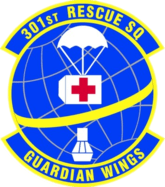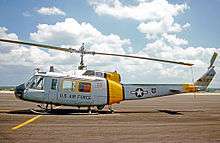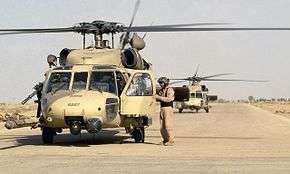301st Rescue Squadron
301st Rescue Squadron
 | |
|---|---|
|
Squadron HH-60 Pave Hawks at Tallil Air Base | |
| Active | 1956-present |
| Country |
|
| Branch |
|
| Role | Search and Rescue |
| Part of | Air Force Reserve Command |
| Garrison/HQ | Patrick Air Force Base |
| Decorations | Air Force Outstanding Unit Award |
| Insignia | |
| 301st Rescue Squadron emblem (approved 2 December 1963)[1] |
 |
The 301st Rescue Squadron is part of the 920th Rescue Wing at Patrick Air Force Base, Florida. It operates HH-60 Pave Hawk aircraft conducting search and rescue missions.
History
%2C_USA_-_Air_Force_AN1641442.jpg)
The 301st was originally activated in August 1956 at Miami International Airport, Florida as an amphibious aircraft unit, equipped with the Grumman SA-16 Albatross and began training for combat search and rescue missions. The 301st performed search and rescue and medical evacuation missions primarily over land areas of and water areas off Florida.[1] It was the first of five rescue squadrons established by Continental Air Command in the Air Force reserve in the 1950s to be activated.[2] In January 1957, the squadron performed the first rescue by a reserve unit.
In 1960, the Air Force moved its units from Miami International Airport, which had become one of the busiest in the world, to Homestead Air Force Base, located south of Miami.[1] From Homestead, the squadron began participating in NASA's manned space flight rescue contingency operations for Project Mercury, beginning with Freedom 7, the first manned Mercury launch, in 1961.

In the 1970s, the squadron converted to a helicopter unit, adding a few Sikorsky HH-34s in 1971, then becoming an all-helicopter unit in 1973, when it added Bell HH-1 Hueys and lost its remaining Albatross amphibians.[1] The Hueys provided support for the Air Force's Water Survival School at Homestead and Biscayne Bay.. In 1974, the squadron began to operate Sikorsky HH-3 Jolly Green Giants, which had an air refueling capability. The squadron became a composite unit in 1979, when it added Lockheed HC-130 Hercules aircraft to refuel its Jolly Greens.[1] It began to provide rescue coverage for space shuttle launches in 1981, and added launch support at the Eastern Test Range in 1993. HH-60 Pave Hawks replaced the Jolly Greens in 1991.[1]
When Hurricane Andrew struck south Florida in August 1992 the squadron rescued 137 residents during the 18-day humanitarian operation following Andrew's landfall. However, Andrew also devastated the squadron's home station and it performed these rescues while operating from Tamiami Airport, Florida. Within a few months, the Air Force determined not to return the 301st to Homestead, and in January 1993 it moved to Patrick Air Force Base, further north in Florida.[1] After the move, on one day in March 1993, the unit saved 93 elderly residents from rising flood waters at their Tampa area retirement community.
In 1997, the Air Force split its composite rescue units. The portion of the 301st flying HH-60G was retained as the 301st Rescue Squadron as it became a helicopter unit again.[1] The HC-130P/N portion of the squadron became the 39th Rescue Squadron and the pararescue portion became the 308th Rescue Squadron. The three squadrons formed the operational element of the 920th Rescue Group.[1][3][4]
The 301st has deployed crews to provide search and rescue coverage worldwide, including to Keflavík, Iceland, during and after the Gulf War, and to the Persian Gulf area since 1993.[1]
Lineage
- Constituted as the 301st Air Rescue Squadron on 9 March 1956
- Activated in the reserve on 18 August 1956
- Redesignated 301st Aerospace Rescue and Recovery Squadron on 18 January 1966
- Redesignated 301st Air Rescue Squadron, 1 April 1990
- Redesignated 301st Rescue Squadron on 1 February 1992[1]
Assignments
- 2585th Air Reserve Flying Training Center, 18 August 1956
- 2586 Air Reserve Flying Training Center, 2 June 1958
- 14th Air Force, 25 June 1960
- 3rd Air Force Reserve Region, 15 July 1960
- Eastern Air Force Reserve Region, 31 December 1969
- Western Air Force Reserve Region, 1 January 1972
- 403d Aerospace Rescue and Recovery Wing (later 403d Rescue and Weather Reconnaissance Wing), 15 March 1976
- 939th Aerospace Rescue and Recovery Group (later 939th Air Rescue Wing, 939th Rescue Wing), 1 October 1987
- 939th Operations Group, 1 August 1992
- 920th Rescue Group, 15 April 1997
- 920 Operations Group, 1 Apr 2003 – present[1]
Stations
- Miami International Airport, Florida, 18 August 1956
- Homestead Air Force Base, Florida, 1 August 1960 (operated from Tamiami Airport, Florida August - December 1992)
- Patrick Air Force Base, Florida, January 1993 – present[1]
Aircraft
- Grumman SA-16 (later HU-16) Albatross (1956–1973)
- Sikorsky HH-34 (1971–1974, 1975)
- Bell HH-1 Huey (1973–1979)
- Sikorsky HH-3 Jolly Green Giant (1974–1991)
- Lockheed HC-130 Hercules (1979–1997)
- Sikorsky CH-3 Jolly Green Giant (1987–1991)
- HH-60 Pave Hawk (1991–present)[1]
References
Notes
- 1 2 3 4 5 6 7 8 9 10 11 12 13 14 Robertson, Patsy (April 6, 2012). "Factsheet 301 Rescue Squadron (AFRC)". Air Force Historical Research Agency. Retrieved July 16, 2016.
- ↑ Cantwell, p. 156
- ↑ Robertson, Patsy (March 27, 2012). "Factsheet 308 Rescue Squadron (AFRC)". Air Force Historical Research Agency. Retrieved July 16, 2016.
- ↑ Endicott, Judy G. (December 11, 2007). "Factsheet 39 Rescue Squadron (AFRC)". Air Force Historical Research Agency. Retrieved July 16, 2016.
Bibliography
![]() This article incorporates public domain material from the Air Force Historical Research Agency website http://www.afhra.af.mil/.
This article incorporates public domain material from the Air Force Historical Research Agency website http://www.afhra.af.mil/.
- Cantwell, Gerald T. (1997). Citizen Airmen: a History of the Air Force Reserve, 1946-1994 (PDF). Washington, D.C.: Air Force History and Museums Program. ISBN 0-16049-269-6. Retrieved October 1, 2014.
See also
| Wikimedia Commons has media related to 301st Rescue Squadron. |
